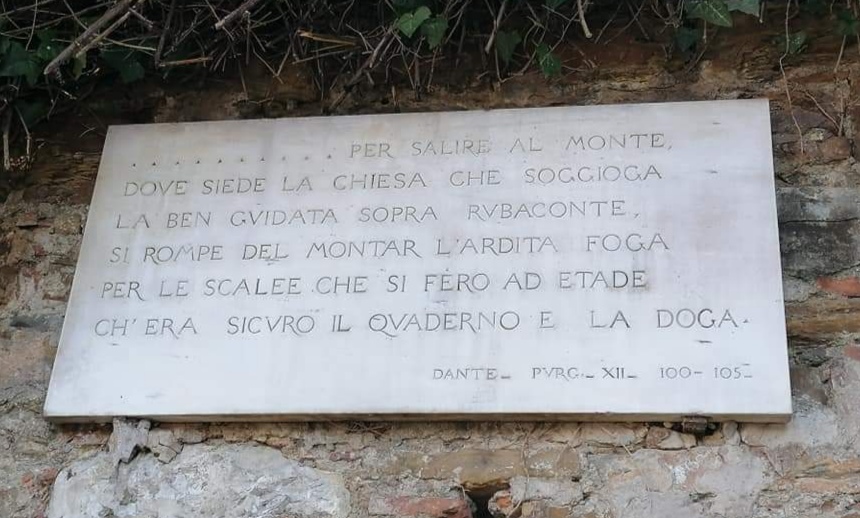By Nadia Fondelli
Translated by Jack Davidson Walmsley
In the year in which the 700th anniversary of Dante Alighieri’s death is celebrated throughout Italy, we would like to propose some curiosities and an unusual trip to his native Florence.The author of the Divina Commedia had a difficult and contrasting relationship with his native city, which forced him to die in exile. But Dante is there in Florence, present more than ever in every stone.The Dante, dressed in red, with a frown, a hollowed face and a big nose, is an image familiar to all of us from our school days, but what few people know is that there is no certainty that this was his real face.

The funerary mask in Palazzo Vecchio, which represents his political history is believed to be the closest image to his real face; It was sculpted in the late 1400s by Pietro and Tullio Lombardo, 150 years after the death of the Great Poet!But what was Alighieri’s true face like then?It will remain a mystery, as will his imaginary love for Beatrice, whom he met by chance when Dante was only nine years old.His Inspirational Muse who led him to revolutionise poetry by creating one of the masterpieces of world literature and to modernise the Italian language forever…
That first meeting, even though they lived next door to each other, took place only nine years later, apparently meeting only three times since the young Beatrice died prematurely at the age of 24.As you set out to explore Florence in the “footsteps” of the poet, you must stop at the so-called Sasso di Dante (Dante’s Stone), located next to the Duomo between Via dello Studio and Via del Proconsolo. Legend has it that the poet spent a lot of time sitting on this rock, absorbed in his thoughts, and that one day a man passing by asked: “Oh Dante, what do you like to eat? And without looking him in the eye, the poet replied: Eggs!The following year, the same man passing in front of the poet absorbed on his usual stone said: And how do you like them? And the answer was, without hesitation: With salt!And here we begin our special itinerary in Florence in the footsteps of the Supreme Poet, following the traces of his Comedy, which narrates the places and events of his native city.

There are 34 marble plaques echoing the tercets from the walls and courtyards of Florence: nine from Hell, five from Purgatory and twenty from Paradise.This itinerary was created between 1900 and 1907 by a committee of Dante enthusiasts, including Isidoro Del Lungo and Pietro Torriganii, with the aim of linking the Comedy to Florence through characters, places and works of art.We begin the tour from the political, religious and social heart of Florence, the city within the walls that Dante lived in, and we conclude outside the walls. For each plaque we will say on which street it is located, to which chant it refers and what connection there is between the Comedy and the city.
Borgo dei Greci, canto XVI, the Peruzzi family; Via del Proconsolo, canto XVI, Ugo il Grande; Piazza del Duomo, canto XXV, dedicated to his baptism in the Baptistery, and canto XXXIII, St Bernard’s prayer to the Madonna; Via Martelli, canto XIX, dedicated to Florence’s Baptistery; Via Cerretani, canto XV, a quotation from Brunetto Latini; Via Tornabuoni, canto XVII, dedicated to the Gianfigliazzi family; Borgo Santissimi Apostoli, canto XVI, dedicated to the Gualderotti family and to Buondelmonte Buondelmonti; Ponte Vecchio canto XII mentioning the river Arno and canto XVI dedicated to the statue of Mars cause of the clashes between Guelphs and Ghibellines destroyed by the flood of the Arno in 1333; via Por Santa Maria canto XVI Amidei family; via Lamberti canto XVI Lamberti family; via degli Speziali canto XVI remembers the ancestors of Dante; via delle Oche canto XVI dedicated to the Florentine dignitaries to the family Visdomini and Adimari; via del Corso chant VIII Filippo Argenti, chant XXIV dedicated to Forese Donati, chant XXX dedicated to Beatrice Portinari, chant XV dedicated to Berlincione Berti Ravignani, chant XVI dedicated to the Cerchi family; via Dante Alighieri chant XXIII dedicated to his birth, chant XV dedicated to his hometown; via Calzaiuoli chant X dedicated to Guido Cavalcanti; via dei Cerchi chant XVI dedicated to the Della Bella family; via dei Tavolini canto XXXII dedicated to Bocca degli Abati, canto XVI dedicated to the Galigai family; Palazzo Vecchio canto X dedicated to Farinata degli Uberti, canto XV on the Uberti family, canto XVI dedicated to ancient Florence; piazza San Salvi canto XXIV dedicated to Donato Corsi; via San Salvatore a Monte and via San Miniato al Monte canto XII dedicated to the basilica of San Miniato and the Rubacante bridge and Piazza Piave canto XIV on the river Arno.